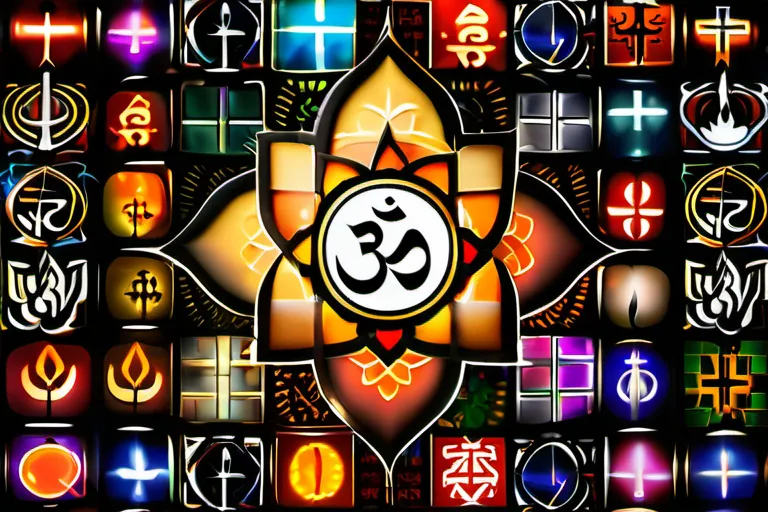Explore the fundamental beliefs that shape Christianity, Islam, Hinduism, Buddhism, and more in this detailed guide.
In this article, we delve into the core beliefs that form the foundation of major religions worldwide. From Christianity’s Holy Trinity to Islam’s Five Pillars, we explore the key tenets that define each faith.
The Holy Trinity: The Foundation of Christian Belief
Imagine diving into the heart of Christianity, where the concept of the Holy Trinity stands like a towering pillar in the landscape of belief. How can three persons be one God? It’s a question that has puzzled and fascinated believers for centuries.
The Holy Trinity, comprising God the Father, Jesus Christ the Son, and the Holy Spirit, is a cornerstone of Christian theology. It’s not just about counting; it’s about understanding the nature of divinity. Each person of the Trinity has distinct roles but shares the same essence and attributes. How can this be possible?
Think of the Trinity as a river with three streams merging into one: the Father, the Son, and the Holy Spirit flowing together to form a single current. This fusion doesn’t dilute their identities; rather, it enriches them, creating a complex yet harmonious unity.
For Christians, this belief goes beyond just intellectual curiosity—it shapes every aspect of life. It’s about recognizing that God is not merely an abstract concept but a dynamic presence in three different yet interconnected forms. How does embracing the Holy Trinity change one’s perspective on faith and everyday life?
The Trinity isn’t just a theological mystery; it’s a living reality that guides believers through their spiritual journey, offering comfort, guidance, and a profound sense of connection to the divine.
The Five Pillars of Islam: A Framework for Faith
Imagine building a house—without a foundation, it would crumble. For Muslims, the Five Pillars serve as that unshakable base, grounding their faith in Islam. These pillars are more than just ceremonial obligations; they’re the spiritual scaffolding that supports a believer’s entire journey towards Taqwa, or godly fear and piety. Let’s delve into each one:
- Shahada: The first pillar, often seen as the cornerstone, is the declaration of faith: ‘There is no god but God, and Muhammad is his Messenger.’ This simple yet profound statement encapsulates the monotheistic belief central to Islam. It’s not just a verbal affirmation; it’s a commitment that shapes one’s worldview and daily actions.
- Salah: Prayer five times a day isn’t merely about ritual; it’s a reminder of constant connection with God. Just as the roots of a tree anchor it to life, prayers ground Muslims in their faith, ensuring they stay aligned with divine guidance.
- Zakat (Charity): This pillar emphasizes giving back to society, reflecting the concept of interconnectedness and responsibility towards others. It’s like sharing a meal; while you may have enough for yourself, extending your hand in generosity enriches everyone’s table.
- Sawm (Fasting during Ramadan): Fasting from dawn till sunset during this holy month symbolizes self-restraint and reflection. It’s as if the body takes a vacation from its routine to focus inward, purifying both the soul and the spirit of unnecessary clutter.
- Hajj: The pilgrimage to Mecca is a physical journey that embodies spiritual transformation. It’s like reaching the summit of Mount Everest; while the journey itself can be challenging, the view from the top makes it all worthwhile. For Muslims, Hajj symbolizes unity and submission to God, transcending personal barriers.
These pillars work in harmony, much like a well-built house. Each one supports and reinforces the others, ensuring that the faith remains strong and resilient. Understanding these five foundational stones can help us appreciate the depth and breadth of Islamic practice and belief.
The Four Noble Truths and Eightfold Path: Buddhism’s Core Beliefs
Imagine walking through a dense forest, trying to find your way out. Each path represents a different belief system, and in this journey, we’ll explore Buddhism’s core beliefs—the Four Noble Truths and the Eightfold Path.
The Four Noble Truths are like the signposts that guide us on this spiritual expedition. The first truth states that life is suffering (dukkha). Is it really as simple as that? Can we truly embrace such a profound statement?
- First Noble Truth: Life is suffering.
- Second Noble Truth: Suffering arises from craving and attachment. Could it be that our desires are the root of our pain?
- Third Noble Truth: The cessation of suffering is possible through the abandonment of craving. Is there a way out, or will we always be trapped in this cycle?
- Fourth Noble Truth: The path leading to the cessation of suffering (the Eightfold Path) involves right understanding, right intention, and so on. How do these steps fit into our lives?
The Eighth Path is like a compass, helping us navigate through life’s challenges. These eight components—right view, right intent, right speech, right action, right livelihood, right effort, right mindfulness, and right concentration—are not just words but actions that transform our being.
By following this path, one aims to achieve enlightenment (nirvana). It’s like reaching the summit of a mountain after enduring the trials of a treacherous climb. The journey is demanding, yet the reward is immeasurable—a liberation from the cycle of birth and rebirth (samsara).
Understanding these core beliefs can transform our perspective on life. They encourage us to reflect deeply on our actions and intentions, guiding us towards a more compassionate and mindful existence.
The Vedas: Hinduism’s Sacred Texts
The Vedas, ancient texts that form the bedrock of Hinduism, are like a vast ocean of knowledge and wisdom. How can such a profound body of literature be understood in its entirety? The Vedas consist of four main parts: Rigveda, Samaveda,
Imagine the Vedas as a treasure chest filled with gold. Inside are not just treasures of wealth but of profound philosophical and spiritual teachings. These texts contain hymns, prayers, and rituals that guide individuals on their path to enlightenment. They explore concepts like dharma, or right living, and reincarnation, suggesting a cycle of birth, death, and rebirth.
The Vedas also delve into the nature of Brahman, the ultimate reality that permeates all existence. This concept is akin to finding the soul within every particle of the universe. Through these texts, Hindus seek to understand their place in the cosmos and how to align themselves with this divine essence.
Moreover, the Vedas introduce yoga, a practice that aims at uniting the individual self (Atman) with Brahman. This is not just physical exercise but a holistic approach involving mind, body, and spirit. Yoga, as described in the Vedas, serves as a pathway to inner peace and spiritual realization.
So, what can we learn from these ancient texts? The Vedas offer a rich tapestry of beliefs that have shaped Hinduism for millennia. They teach us about the interconnectedness of all life and the pursuit of moksha, or liberation from the cycle of birth and death. These texts remind us that our journey is not just individual but part of a larger cosmic dance, guided by timeless wisdom.
The Tao Te Ching: The Core Beliefs of Taoism
The Tao Te Ching, a foundational text of Taoism, stands as a poetic yet profound guide to living in harmony with the Tao, the ultimate source and essence of all existence. Have you ever wondered how one can find peace amidst life’s chaotic whirlwind? The Tao Te Ching offers insight through its 81 concise verses, each weaving a tapestry of wisdom that challenges our perception of reality.
At its core, the Tao Te Ching encourages living in accordance with nature. It poses questions like, ‘Can you embrace simplicity and still find fulfillment?’ By advocating for humility and non-action (wu wei), it suggests that true power lies not in forced action but in effortless alignment with the natural flow of life. This is akin to riding a wave instead of trying to swim against it.
The text also emphasizes the balance between yin and yang, representing dualities such as light and darkness, strength and gentleness. By recognizing these inherent opposites, one can navigate life’s challenges more gracefully. Rhetorically, we might ask, ‘How do you achieve harmony within yourself when everything around you seems to be in constant flux?’
Furthermore, the Tao Te Ching delves into the concept of simplicity and emptiness. It invites us to look beyond material possessions and societal norms. ‘Is your life cluttered with too much unnecessary baggage?’ it asks. By embracing simplicity, one can find inner peace and clarity, making room for deeper understanding and compassion.
The Tao Te Ching challenges our usual ways of thinking, urging us to see the world through a lens of wu wei—action that flows naturally from within rather than forcing outcomes. This ancient wisdom offers a roadmap for living a more harmonious life, where each step aligns with the natural order and promotes peace not just for oneself but for all.
The Role of Rituals and Practices in Religious Beliefs
Rituals and practices are like the threads that weave together the fabric of religious beliefs, giving them shape and substance. In Christianity, for instance, the act of communion, symbolizing the body and blood of Christ, serves as a powerful reminder of His sacrifice and the unity among believers. Imagine walking into a church on a Sunday morning, where the scent of incense fills the air and the rhythmic hymns echo through the space. This ritual becomes more than just a service; it’s a journey, a reenactment of faith that strengthens spiritual bonds.
In Islam, prayer (salat) is a daily practice that connects Muslims to their Creator. The call to prayer, echoing from minarets, can be seen as a bell, calling believers to reflect on their lives and responsibilities. Each line of prayer is not just recitation; it’s a conversation with God, reinforcing the belief in His omnipresence and omnipotence.
Hinduism, with its myriad practices, is like a vast tapestry where rituals such as puja (worship) play a central role. These rituals involve offerings to deities, often seen as a way of bridging the gap between humans and the divine. The act of offering flowers or lighting lamps can be both an expression of devotion and a form of purification, cleansing the mind and heart.
Buddhism introduces us to practices like meditation (bhavana), which is akin to silence, helping practitioners find inner peace and clarity. Through mindfulness and concentration, Buddhists seek to understand the nature of reality and achieve enlightenment. The practice itself becomes a path, guiding one through the complexities of life toward spiritual awakening.
Even in religions that don’t emphasize formal rituals as much, such as Taoism, there are practices that reinforce core beliefs. The yin-yang symbol, for example, is not just an abstract concept but a way of life, reminding practitioners to balance opposing forces in their lives. These practices and rituals become the bedrock upon which religious convictions are built, serving as both a reflection of faith and a means to deepen it.
Conclusion
 By understanding these core beliefs, you will gain a deeper appreciation for the diversity and richness of religious traditions across the globe.
By understanding these core beliefs, you will gain a deeper appreciation for the diversity and richness of religious traditions across the globe.











